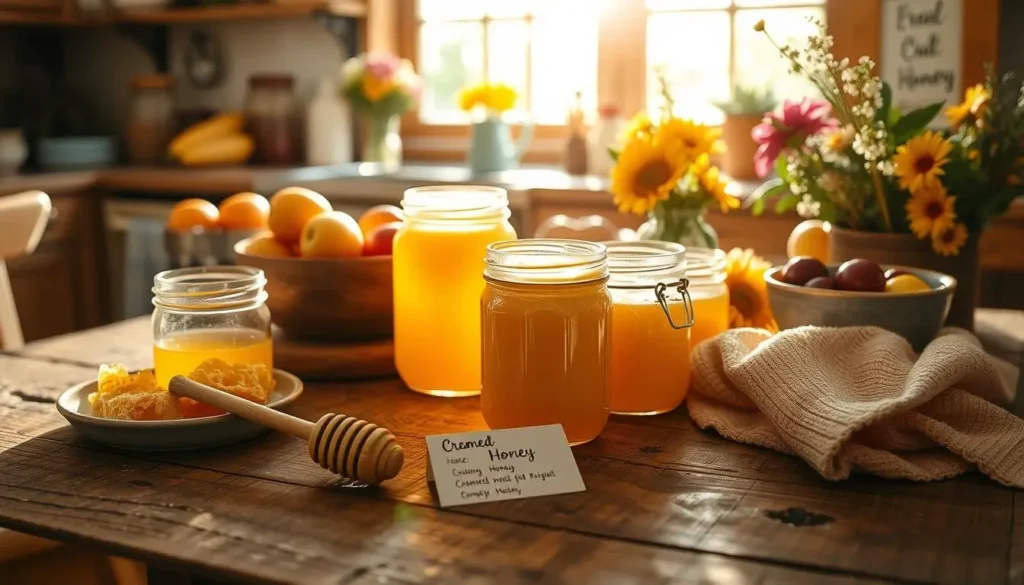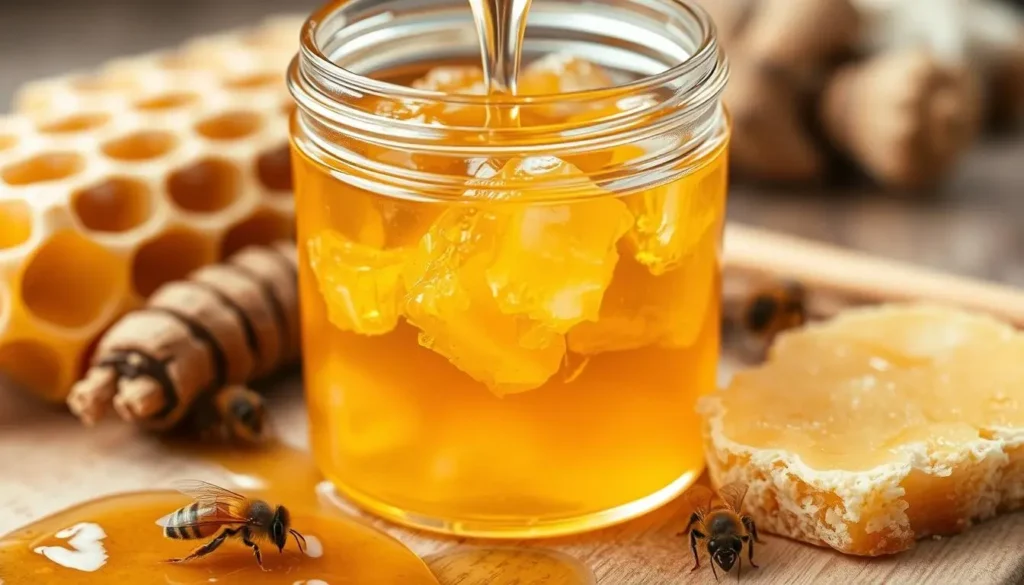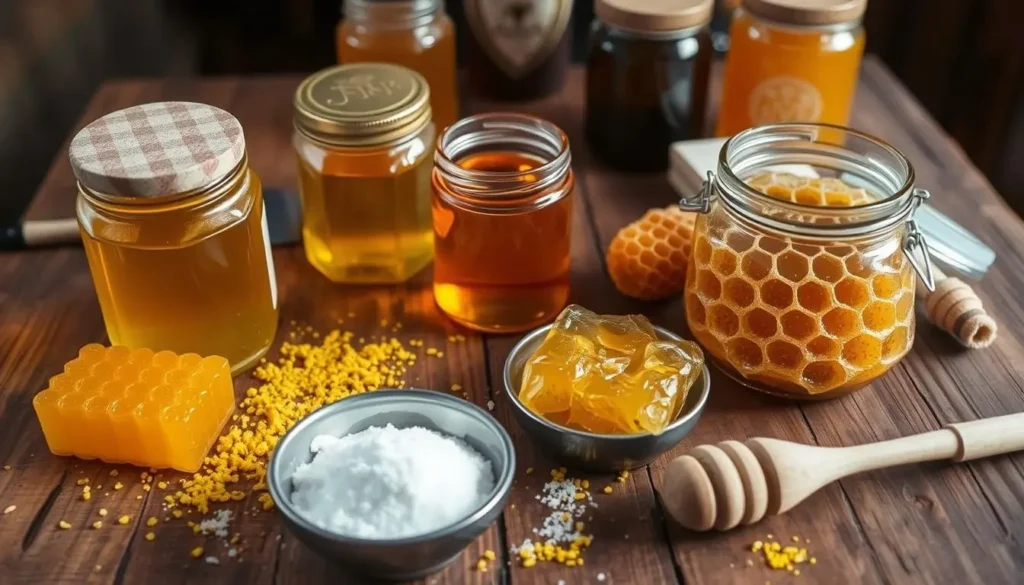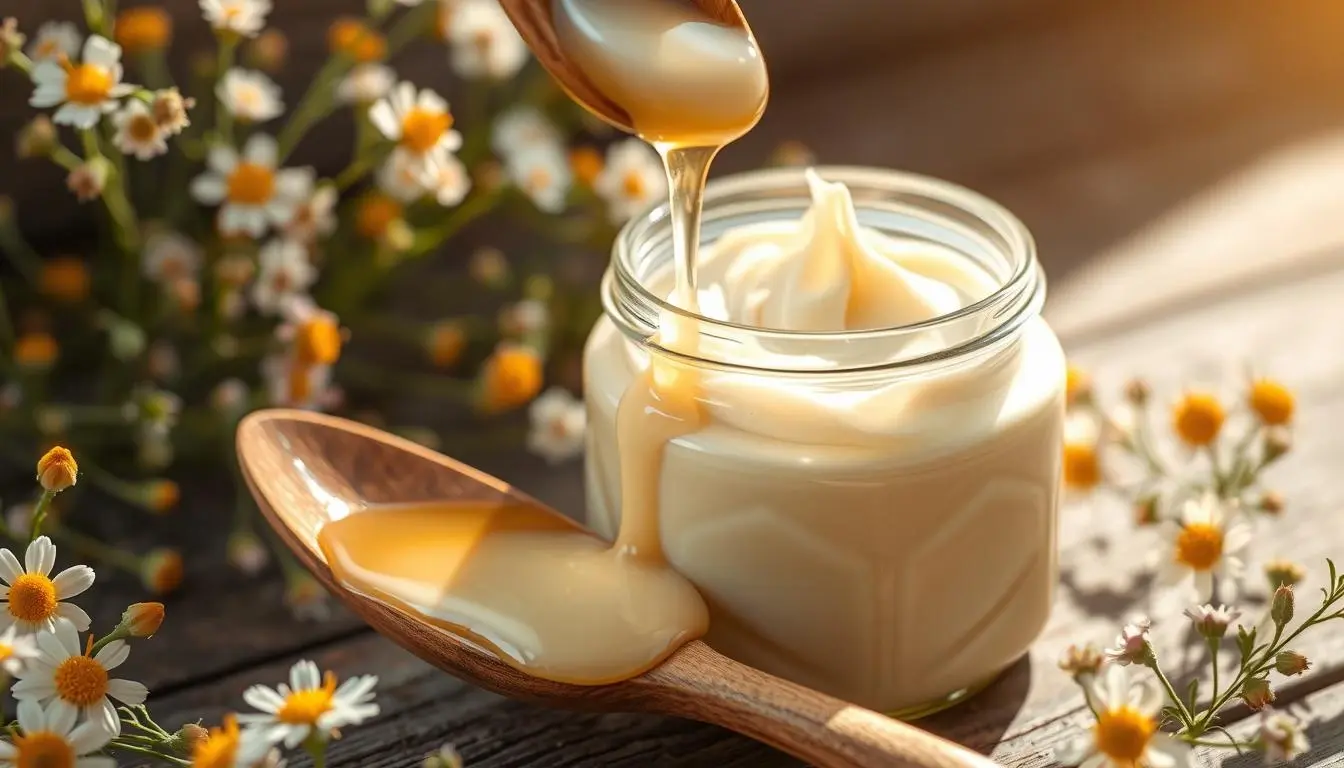I love cooking at home and making tasty treats from scratch. Homemade creamed honey caught my eye. It’s smooth and spreadable, loved by many. I wanted to make it in my kitchen.
Think about putting this honey on toast, in tea, or on scones. It’s versatile and fun to make. This guide will show you how to make creamed honey at home. You’ll learn how to get the right texture and enjoy its benefits.
Table of Contents
Understanding What Creamed Honey Is
Creamed honey, also known as soft-set honey, is a special type of honey. It’s different from regular honey because it’s smooth and spreadable. This makes it great for many recipes.
The Science Behind Honey Crystallization
The change from liquid to creamed honey happens through crystallization. This is when the glucose in honey turns into tiny crystals. These crystals make the honey creamy. The honey crystallization process depends on temperature, humidity, and the honey’s makeup.
Differences Between Regular and Creamed Honey
- Texture: Regular honey is liquid, while creamed honey is thick and spreadable.
- Appearance: Creamed honey looks smooth and uniform. Regular honey can vary in texture.
- Taste: Creamed honey tastes sweeter and more intense than regular honey.
- Crystallization: Creamed honey is made through controlled crystallization. Regular honey crystallizes naturally over time.
Natural vs. Artificial Crystallization
The soft-set honey we love is made through careful crystallization. Some honey crystallizes naturally, but creamed honey is made by adding pre-crystallized honey. This ensures it’s smooth and consistent.

“Creamed honey is a delightful way to enjoy the natural sweetness of honey with a unique, spreadable texture.”
Essential Equipment and Ingredients for Making Creamed Honey
Making your own creamed honey at home needs a few key tools and the best raw honey. With the right gear and honey, you’ll get a smooth, creamy texture. This will make your cooking and baking better.
To start making creamed honey, you’ll need:
- A large bowl or container – It should be stainless steel or food-grade plastic. This is where you’ll mix everything.
- A sturdy whisk or hand mixer – This tool is key for blending the honey until it’s smooth.
- A thermometer – It’s important to check the honey’s temperature for good crystallization.
- A clean, airtight container – This is where you’ll store your finished creamed honey.
The most crucial ingredient is high-quality raw honey. Choose a local, unprocessed honey that tastes great and is smooth. Stay away from processed or commercial honey. They might not crystallize well.
“Using the right raw honey is the key to making exceptional creamed honey at home.”
With the right tools and the best raw honey for recipes, you’re ready to make a tasty, homemade spread. It will take your cooking and baking to the next level.

Benefits of Making Your Own Whipped Honey
Making your own whipped honey at home has many benefits. It’s great for your health and can save you money. Plus, it’s easy to store at home.
Health Advantages of Homemade Creamed Honey
One big plus of homemade whipped honey is its health benefits. It keeps more of the natural goodness found in honey. This means you get a sweeter treat that’s also good for you.
Cost-Effectiveness and Storage Benefits
Making your own whipped honey uses saves you money. You avoid the high prices of store-bought honey. Plus, your homemade natural honey recipes last longer, so you can enjoy it for weeks without worrying about it going bad.
Looking for a healthier sweetener or wanting to cut costs? Making your own whipped honey is a smart choice. It’s fun to make and adds a special touch to your kitchen.

“Homemade creamed honey is a true delight, offering unparalleled flavor and health benefits.”
Selecting the Right Raw Honey for Your Recipe
Choosing the right raw honey is crucial for making creamed honey at home. Not all honeys are good for creaming. It’s important to know the differences and pick the best one.
The floral source of the honey matters a lot. Honeys from flowers like clover, alfalfa, or wildflowers crystallize easily. This makes them perfect for creamed honey. But, honeys from eucalyptus or sage have more fructose. They might not whip up as well.
- Choose raw, unprocessed natural honey recipes with a light to medium color. They should be smooth and creamy.
- Stay away from honeys that have been heavily filtered or pasteurized. These methods can mess up the honey’s ability to crystallize.
- Think about when the honey was harvested. Early-season honeys have more glucose. This helps them crystallize faster and more evenly.
To find the right raw honey for your recipe, try different ones. You’ll soon discover the perfect honey for your creamed honey. With a bit of experimentation, you’ll make a delicious, spreadable treat.
The Step-by-Step Process of Making Creamed Honey
Making your own creamed honey is a fun and rewarding task. It only takes a few steps to turn raw honey into a smooth spread. Let’s dive into the key steps to make creamed honey at home.
Temperature Control Guidelines
When making creamed honey, keeping the temperature just right is key. The honey should be between 104°F and 113°F (40°C and 45°C). This ensures it crystallizes evenly and gets that creamy texture you love.
Mixing and Blending Techniques
Once your honey is at the right temperature, it’s time to mix it gently. Use a stand mixer or handheld whisk to blend it slowly. This step, called creaming, makes the honey smooth and spreadable.
Setting and Curing Times
After mixing, put the honey in clean, sterilized containers. Let it set and cure at room temperature for 24 to 48 hours. This time is crucial for the honey to fully develop its creamy texture. Once it’s cured, your homemade creamed honey is ready to enjoy!
The secret to perfect how do you make creamed honey is controlling the temperature, mixing right, and being patient. With a bit of practice, you can make your own delicious, spreadable honey at home.
Common Mistakes to Avoid When Making Whipped Honey
Making whipped honey at home can be rewarding but tricky. To avoid problems, it’s key to know the common mistakes. We’ll cover these errors and offer tips for smooth, creamy honey every time.
One big mistake is not controlling the temperature right. Honey doesn’t like too much heat. Keep the temperature just right to avoid soft or hard honey.
- Avoid letting the honey get too hot, as this can damage the delicate flavor and aroma.
- Ensure the whipping container is clean and dry before adding the honey to prevent unwanted contaminants.
- Take care not to over-whip the honey, as this can cause it to become grainy or gritty in texture.
Choosing the wrong honey is another mistake. Not all honeys work well for whipped honey. Pick a honey with more glucose for better texture.
| Common Mistake | Solution |
|---|---|
| Improper temperature control | Monitor temperature closely and keep within optimal range |
| Using the wrong type of honey | Choose a honey with a higher glucose content |
| Over-whipping the honey | Avoid excessive whipping to prevent a grainy texture |
By avoiding these mistakes and following good practices, you’ll make amazing whipped honey. It will taste great and impress everyone.
Best Storage Practices for Homemade Creamed Honey
Keeping your homemade creamed honey fresh is key to enjoying its taste and health perks. To keep your honey spread smooth and tasty, follow these storage tips.
Optimal Temperature Conditions
Store creamed honey in a cool, steady spot, between 50°F and 70°F. Don’t let it get too hot or cold, as this can make it crystallize early. The best place is a dark, dry spot like a pantry or kitchen cabinet, away from sunlight or heat.
Container Selection Tips
- Go for an airtight container made of glass or food-grade plastic to keep out moisture and air.
- Choose containers with tight lids or seals to keep the smooth honey texture and stop it from drying out.
- Stay away from metal containers, as they can change the honey’s taste and look.
- Think about using smaller containers. They have less air space, which helps keep the how to store creamed honey fresh.
By sticking to these easy storage tips, your homemade creamed honey will stay smooth and delicious for months.
Creative Ways to Use Your Creamy Honey Spread
Creamy honey spread, also known as whipped honey, is a versatile ingredient. It can make your dishes better in many ways. It’s not just for toast or dips; it opens up a world of possibilities.
Using it as a sweetener in baked goods is a great idea. Try drizzling it over muffins, scones, or pancakes. It adds natural sweetness and a creamy texture. You can also mix it into batters and frostings for cakes, cookies, and more.
- Swirl it into yogurt or oatmeal for a delightful breakfast delight
- Pair it with fresh fruit, such as apples, pears, or berries, for a healthy and indulgent snack
- Use it as a glaze or marinade for roasted vegetables or proteins
- Stir it into your favorite tea or coffee for a creamy, honey-infused beverage
- Spread it on toast or bagels for a comforting and satisfying breakfast or snack
There are endless ways to use your homemade creamy honey spread. Try different flavors and combinations. This will help you find new and exciting ways to enjoy it.
Remember, the key to using your creamy honey spread is to be creative and have fun. So, don’t be afraid to get creative and whip up some delicious and creamy honey-based treats!
Troubleshooting Your Honey Crystallization Process
Making your own creamed honey can be rewarding, but you might hit some bumps. Don’t worry, we’re here to help you fix any texture or crystallization problems.
Fixing Texture Issues
If your creamed honey is grainy or coarse, there are ways to fix it. First, make sure you’re mixing at the right temperature. The right temperature is key for a smooth, creamy texture. Also, be careful not to over-mix, as this can make it gritty.
Addressing Crystallization Problems
Crystallization in honey is natural, but you can control it for a creamy texture. If your honey crystallizes too fast or unevenly, try heating it gently. Then, blend it again. This helps even out the sugar crystals and makes it smooth.
Getting the honey crystallization process and a smooth honey texture right might take some tries. But with patience and the right methods, you’ll make the creamy, tasty homemade creamed honey you dream of.
By tackling these common problems and following the best methods, you’ll have a successful creamed honey-making journey. Your homemade honey will look and taste great, and it will make your cooking even more enjoyable.
Adding Flavors and Variations to Your Creamed Honey
Make your homemade creamy honey even better by adding exciting flavors and unique twists. Discover a world of tastes that will make your mouth water and your senses happy. Learn how to mix flavors and turn your honey into a culinary work of art.
Spice it Up with Warm Flavors
Cinnamon, ginger, and nutmeg are great with creamy honey. Add a teaspoon or two of these spices for a cozy touch. This mix of sweet and spice is perfect for breakfast oats or baked goods.
Citrus Infusions for a Bright Touch
Add a zesty touch with citrus zest. Use orange, lemon, or lime zest in your honey. This brightens the flavor, making it great for marinades, dressings, or just enjoying on its own.
Herbal Honey for a Soothing Experience
Make your honey soothing with herbs like lavender, chamomile, or rosemary. These herbs add calming flavors, perfect for before bed or in tea.
| Flavor Combination | Suggested Use |
|---|---|
| Cinnamon Creamy Honey | Drizzle over oatmeal, bake into granola bars, or use as a glaze for baked goods |
| Lemon Zest Creamy Honey | Whisk into salad dressings, spread on toast, or use as a sweetener in beverages |
| Lavender Creamy Honey | Stir into herbal tea, use as a topping for yogurt or ice cream, or enjoy on its own |
Get creative and try different ingredients to make your own creamy honey recipes. There are countless options, so let your taste buds guide you in exploring natural honey flavors.
Understanding Shelf Life and Preservation Methods
Keeping your homemade creamed honey fresh is key to enjoying its taste and health perks. Knowing how long it lasts and how to store it right keeps it tasty for months.
Signs of Spoilage to Watch For
It’s crucial to spot when your creamed honey might be bad. Look out for these signs:
- Changes in color, such as darkening or discoloration
- Unusual or unpleasant odors
- Visible mold or growth
- Noticeable changes in texture or consistency
If you see any of these, it’s time to toss the honey to stay safe.
Extending Storage Duration
To make your creamed honey last longer, try these tips:
- Store it in an airtight container, like a glass jar or BPA-free plastic.
- Keep it in a cool, dark spot, like a pantry or cabinet, away from sunlight and heat.
- Keep the temperature steady, between 50°F and 70°F, to stop it from crystallizing too soon.
- Don’t put it in the fridge, as it can get gritty or grainy.
- If it starts to crystallize, warm it up in a water bath to melt the crystals.
With the right storage, your homemade creamed honey can stay fresh for up to 2 years.
Using these storage and care tips will help your natural honey recipes last longer. This way, you can enjoy your homemade creamed honey for months.
Health Benefits and Nutritional Value
Raw honey and creamed honey are great natural sweeteners. They have vitamins, minerals, and antioxidants. These help keep you healthy.
Creamed honey is as nutritious as regular honey. It’s full of B vitamins. These vitamins help with energy, immune function, and skin health.
| Nutrient | Amount per Tablespoon of Creamed Honey |
|---|---|
| Calories | 64 |
| Carbohydrates | 17g |
| Sugars | 17g |
| Vitamin B6 | 0.024mg |
| Riboflavin (B2) | 0.013mg |
| Niacin (B3) | 0.011mg |
Creamed honey also has minerals like iron, calcium, and zinc. These are good for bones, immune function, and metabolism.
“Honey is a natural sweetener that can provide you with various health benefits, including improved digestion, wound healing, and even allergy relief.”
The creaming process keeps honey’s health benefits. It’s good for fighting microbes and inflammation. This makes creamed honey great for raw honey for recipes.
Use creamed honey in baking, on oatmeal, or as a spread. It’s a tasty way to boost your health.
Commercial vs. Homemade Creamed Honey Comparison
Choosing between store-bought and homemade whipped honey involves several factors. Commercial creamy honey spread is convenient, but making your own offers quality, cost, and customization benefits.
Homemade creamed honey is fresher and of higher quality. Commercial honey may lose natural flavors and nutrients due to processing. Making your own whipped honey lets you keep the honey’s raw, unfiltered goodness. This ensures a more authentic taste and a creamier texture.
| Feature | Commercial Creamy Honey Spread | Homemade Whipped Honey |
|---|---|---|
| Taste and Texture | May be more processed and lose natural flavors | Retains the pure, raw flavor and creamy consistency |
| Nutritional Value | Potential loss of beneficial enzymes and nutrients | Preserves the honey’s natural health properties |
| Cost | Typically more expensive per ounce | Can be more cost-effective in the long run |
| Customization | Limited flavors and variations | Allows for personalized flavors and add-ins |
Making your own Creamy honey can save money over time. You control the quality and quantity of ingredients. Plus, you can customize it with unique flavors and add-ins like nuts, spices, or dried fruits.
The choice between commercial and homemade creamy honey spread depends on your preferences, budget, and desired control. Knowing the differences helps you make a choice that meets your needs and ensures a great whipped honey experience.
Tips for Achieving the Perfect Smooth Texture
Making perfect Creamy honey is more than just a recipe. To get a smooth and creamy texture, you need to know a few tricks. Follow these expert tips to make your homemade smooth honey texture better. You’ll love the luxurious spun honey on your morning toast.
- Proper Temperature Control: The right temperature is key for a smooth texture. Heat your honey to 104-113°F (40-45°C) while whipping. This helps it crystallize slowly without getting too thin.
- Slow and Steady Whipping: When making how to make spun honey, be patient. Whip the honey slowly to medium speed. This lets it thicken and get creamy. Whipping too fast can make it grainy.
- Seed with Finely Crystallized Honey: Adding a bit of already crystallized honey helps. It acts as “seed” crystals for the rest of the honey. This makes it smooth and uniform.
- Curing Time: Let your creamed honey rest for 24-48 hours after whipping. This time is important for the perfect smooth honey texture. Store it in an airtight container during this time.
Mastering these techniques will help you make homemade Creamy honey. It will have a luscious, spreadable texture. Enjoy the sweet results of your hard work!
“The secret to perfect Creamy honey lies in patience and precision. With a little practice, you can achieve that coveted smooth and creamy texture right at home.”
Conclusion
In this article, you learned how to make your own creamy honey spread at home. You now know the science behind honey crystallization and how to make it. This means you can create a homemade honey recipe that’s just as good as store-bought ones.
Making your own creamy honey spread has many benefits. It’s healthier, more cost-effective, and you can customize it to your liking. By choosing the right raw honey and using the right techniques, you can make a smooth honey. This honey can add sweetness to your favorite foods and drinks.
Now that you know how to make homemade honey recipes, try new flavors and uses. Share your creations with friends and family. Making your own honey spread is a fun way to show off your cooking skills and bring happiness to others.
FAQ
What is creamed honey or whipped honey?
Creamed honey, also known as whipped honey, is a smooth, spreadable honey. It’s made by controlling the natural crystallization of honey. This process gives it a creamy texture.
How does the honey crystallization process work?
Honey crystallizes naturally over time. The glucose in the honey turns solid, forming crystals. For creamed honey, this process is managed to get a smooth texture.
What are the differences between regular and creamed honey?
Regular honey stays liquid, while creamed honey is thicker and creamier. It’s also smoother to spread. This is because of the controlled crystallization.
How is creamed honey different from artificial or rapid crystallization?
Creamy honey uses natural crystallization. Artificial methods might use additives. This natural way makes Creamy honey smooth without chemicals.
What equipment and ingredients are needed to make creamed honey at home?
You need raw honey, a mixing tool, and a container. You can use a stand mixer, hand mixer, or whisk, depending on the amount you make.
What are the benefits of making your own creamed honey?
Making your own Creamy honey is healthy and cost-effective. It also keeps better, keeping its quality longer.
How do I select the best raw honey for making creamed honey?
Choose high-quality, minimally processed honey. Local or trusted sources are best. Consider honey types like clover or wildflower for creaminess.
What is the step-by-step process for making creamed honey at home?
Start by controlling the temperature and mixing the honey. Then, let it set and cure. This ensures a smooth texture.
What are some common mistakes to avoid when making whipped honey?
Avoid overheating the honey and not controlling the temperature. Also, don’t skip the curing step. Knowing honey’s crystallization is key to success.
How should I store homemade creamed honey?
Store it in a cool place, 50-70°F, in airtight containers. This keeps it smooth. Avoid temperature changes to preserve quality.
How can I use creamed honey in my cooking and baking?
Use it in sweet and savory dishes. It’s great in baked goods, on yogurt, or as a sweetener. It also adds flavor to marinades and dressings.
How can I troubleshoot issues with the honey crystallization process?
If your honey isn’t right, try adjusting the temperature or mixing. Fixing the initial crystallization can also help.
Can I add flavors or create variations to my homemade creamed honey?
Yes! You can add spices, herbs, or citrus zest. This makes unique flavors for your creamed honey.
How long does homemade creamed honey last, and how can I extend its shelf life?
Stored right, it lasts months or up to a year. Keep it cool, use airtight containers, and avoid moisture.
What are the health benefits and nutritional value of creamed honey?
It’s full of antioxidants, enzymes, and other good stuff. As raw honey, it’s a natural, healthy sweetener.
How does homemade creamed honey compare to store-bought varieties?
Homemade is better because you control the ingredients and flavors. It’s also more cost-effective and can be of higher quality.
What are the best techniques for achieving the perfect smooth, creamy texture in homemade creamed honey?
Control the temperature, mix right, and understand crystallization. With practice, you’ll get a smooth, spreadable honey.

